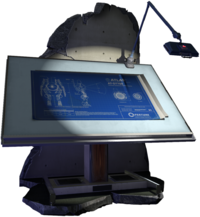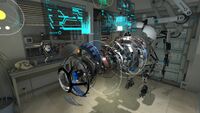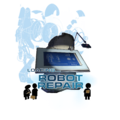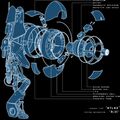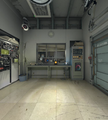Robot Repair
| This article is non-canon. | ||
|---|---|---|
The subject matter of this article does not take place in the "real" Half-Life and Portal universe and is considered non-canon. |
This article is a stub. Maybe you can help by expanding it. |
|---|
| Preceded by Secret Shop |
Robot Repair | Succeeded by Solar System |
|---|---|---|
| Experiment name | Description | Comments |
| Johnson-Micro After one of the several famous scientists named Johnson. |
Traverses to Aperture Science, where a damaged AT-D7796 robot requires assistance. | So that's what happened to Lab 44. |
| Item: An ATLAS figure. | ||
Robot Repair (in-universe name Experiment Johnson-Micro) is the sixth minigame / experiment of The Lab. It was first shown at the Game Developers Conference on March 4, 2015 during the Advanced VR Rendering session by Alex Vlachos.[1] It runs on a special version (engine branch) of Source 2.[2][3]
It was first released along with the SteamVR Performance Test on February 22, 2016, under the name Aperture Robot Repair,[4] and as part of The Lab under its final name, Robot Repair.
Contents
Relic[edit]
The relic in the hub consists of the fragment of a wall and floor and a drawing board with an ATLAS blueprint and a lamp whose position can be adjusted and turned on and off.
Minigame[edit]
The demo is set in a maintenance room used as the Robot Rehabilitation and Wellness Center that is located in a large area connected to an unidentified Enrichment Shaft in the lowest levels of the Aperture Science Enrichment Center. The game consists of repairing a damaged AT-D7796 (ATLAS) robot, a test to get a job into Aperture Science's Human Diversity Outreach Program. The Announcer gives instructions throughout the game. The protagonist, referred to as a repair associate, is the inaugural participant. To perform the task, they use a pair of Dual Aperture Science Prosthetic Multitools, the in-universe equivalent of the VR controllers. The room features a wall clock displaying the actual time of the UTC−05:00 time zone, used by Michigan where the Enrichment Center is located.
The first task is to open the proper drawer in the nearby cabinet. They either contain an ATLAS blueprints and tools, a moldy cake, or an Aperture Science Pocket Universe Cabinet made of a miniature office area filled with miniature Bendies, an office similar in design to the ones seen in the videos "Romance Safety Compliance Guide" or "Perpetual Testing Initiative". Looking at the drawer disrupts their universe, turning the player into their god, and thus the Contaminated Pocket Universe Contingency Protocol must be initiated, incinerating them. No matter the choice, the drawer opening task can't be successfully completed.
The Announcer then tells the player to walk across the room and pull a lever of the nearby service bay door, resulting in meeting ATLAS and P-body in a state of disrepair in a waiting room. ATLAS enters the maintenance room while P-body stays in the waiting room, reading QR codes in an issue of the Parts Illustrated magazine, trembling. The messy and slightly decrepit waiting room contains two illustrations of Robot Workers, an eye chart with working QR codes, a Reality Check spring-loaded weighing scale (that gives a "honest weight"), a water cooler, stacked chairs, and a sideboard with leaflets (one titled "Neurotoxins and You - Our responsibility as science professionals", and one reproducing a warning sign originally appearing in the 1980s levels of Test Shaft 09 in Portal 2), as well as real-world books related to Valve's other IPs, placed there as Easter eggs, including the Dota 2 comic book Tales from the Secret Shop, Team Fortress 2’s Saxton Hale comic books Saxton Hale's Mail Storm and Girl's Adventure Starring Saxton Hale, and Half-Life 2: Raising the Bar.
The player is then told to press a button on ATLAS to expand the robot's countless components in order to repair him (one of them being a rectangular "HEV module" bearing the Black Mesa logo[5]). Due to the limited time and complexity of the task, they fail again as ATLAS breaks down and collapses along with the whole room. The Announcer is dissatisfied with the player's performance and says that they are now not qualified to do anything.
The player then hears GLaDOS wondering out loud how a robot could fail such a simple mission. With the help of a Security Camera, she discovers that it wasn't a machine's fault. As the room around the player is rebuilt, GLaDOS says that he has done well as far as humans go, and that he was relieved of his duties. The demo then fades out.[6]
A variant of the ATLAS figure awarded after playing Robot Repair is awarded in SteamVR Home for playing The Lab itself.
Behind the scenes[edit]
Despite Robot Repair being released first, Secret Shop was actually the first minigame to be designed for The Lab. Robot Repair was worked on for their hardware showcase at GDC 2015 instead after they realized Secret Shop was more of an exploration space and didn't work well for a tight time demo more fitting for a conference. Just like Secret Shop, using high-res assets was a priority, the main difference being in building a narrative experience and have something that fits within a five minute demo but that gives people a sense of progression through the environment and have as much variety as possible in the interactions and events occurring.[7]
During development, there was also a lot of assumptions and improvisation, as the team didn't have final hardware, no controllers and no 360 tracking yet. Thus the interactions were to be made with the head as the only trackers were on the headset but didn't work properly, until, late into development, they finally had controllers.[7]
The eye chart featured on the left side of the waiting room features working QR codes. From left to right: the first row code reads "Hello :)", the second row codes read "http://b.snappr.net/3c05o" (a link that has since expired and is now potentially unsafe) and "bad coffee", and the third row codes read "version 2" twice and "http://goo.gl/4gokF" (a shortened link to http://www.activehistory.co.uk/QR/overview.php, a QR treasure hunt generator made by Russel Tarr, Head of History at the International School of Toulouse). The next rows repeat the previous codes until they are unreadable. The Parts Illustrated magazine that P-body also features QR codes, which are again "Hello :)" and "bad coffee".
Gallery[edit]
Misc.[edit]
Screenshots[edit]
References[edit]
- ↑ Game Developers Conference 2015 - Schedule (archived)
- ↑ Joe Ludwig's tweet (March 4, 2015)
- ↑ Advanced VR Rendering slides on Valve's official website (March 2015)
- ↑
 SteamVR Performance Test on Steam
SteamVR Performance Test on Steam
- ↑ Half-Life easter egg discovered in Aperture Robot Repair - Atlas has an "HEV module". (February 22, 2016)
- ↑ HTC's Vive made me believe in VR on Engadget (March 4, 2015)
- ↑ 7.0 7.1
 Developing The Lab on YouTube
Developing The Lab on YouTube
External links[edit]
 Playthrough (with commentary) on YouTube
Playthrough (with commentary) on YouTube Playthrough (without commentary) on YouTube
Playthrough (without commentary) on YouTube- Advanced VR Rendering slides on Valve's official website (March 2015)
